Ah, pivots.
A maneuver that really needs no introduction as we’ve all seen the good, the bad, and the ugly and we all know it’s a maneuver that needs perfecting if we want to win in the Showmanship and/or the Horsemanship.
GoHorseShow sat down with AQHA Professional Horseman and judge Robin Frid, whose clients have a combined 38 World and Congress Champions and Reserve Champions in Horsemanship and Showmanship, to break down what makes a great pivot, how to avoid a bad one, and how to work on pivots at home so you can be perfect in the show pen.
Pivoting Perfectly in Showmanship
Frid said the most common mistake he sees handlers make in the Showmanship is not keeping their horse square throughout the entire pivot. Staying square means that the handler keeps their horse’s entire body in a perfectly straight line as it moves around that pivot foot.
In order for a horse to stay square throughout a pivot, Frid said, “A horse has to use their back. They can’t hollow out. Their hip needs to stay underneath them, it doesn’t turn to the inside, and the rib cage doesn’t move left or right.”
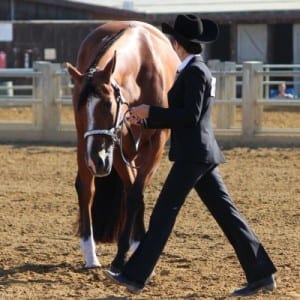 And while the aforementioned elements are crucial to a perfect pivot, what Frid stressed the most was the handler’s ability to control the horse’s head, neck, and shoulders.
And while the aforementioned elements are crucial to a perfect pivot, what Frid stressed the most was the handler’s ability to control the horse’s head, neck, and shoulders.
The reason this is so pivotal (no pun intended) is because when a horse’s head, neck, and shoulder moves out of that straight line, the risk of moving out of the pivot increases significantly.
“A handler needs to have complete control of a horse’s head, neck, and shoulder in order to perform a perfect pivot,” he said. “And a horse doesn’t necessarily have to drop their head either, it just has to respond to the handler.”
He continued, “The moment they move their head, your line is done. The horse’s shoulder needs to be the first thing that moves in order for that horse to stay square.”
Because a perfect pivot relies so much on this control, Frid suggested this should become the main focus of practice at home.
“When you practice your pivots, if the horse moves their head at all, pull them back into place, even going as far as to execute a pull turn to get their head back onto their shoulders,” he said.
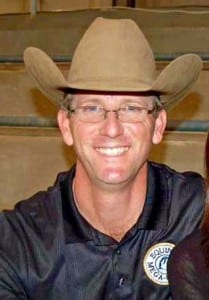 He also stressed that rewarding your horse when they keep their head and neck straight is just as crucial.
He also stressed that rewarding your horse when they keep their head and neck straight is just as crucial.
“We pet on our horses all the time when they do it right,” he said, “The reason we stress this is because if a horse gets used to bending their head out of the line, they get lazy, and then you have a whole new world of problems.”
And, of course, Showmanship is all about being a “showman” so pivots aren’t just about a well-trained horse. A handler is really the one responsible for helping to keep that horse square throughout the pivot.
In order to do this, Frid said, “The handler needs to stay slightly in front of the horse.”
“You don’t want to get too close to the horse,” he said, “you also don’t want to get too far ahead. Getting too close, you risk pushing your horse back out of the pivot. If you get too far ahead, you risk pulling them forward out of the pivot. You have to let them know you are coming.”
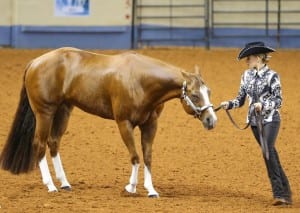 In addition, Frid recommends that handlers get comfortable with paying attention to not only the pivot foot, but the off foot as well.
In addition, Frid recommends that handlers get comfortable with paying attention to not only the pivot foot, but the off foot as well.
“Paying attention to the off foot actually helps keep the pivot foot square,” he said, “when that off foot gets wide a horse will walk out of a pivot. And if it gets too tight the horse will back out of the pivot.”
He had some remarkable advice that he credits to his wife, Jenny Jordan-Frid: “On every quarter [90°] turn the off foot should come back up square to the pivot foot. This helps to make sure the horse is staying underneath itself and also sets you up immediately if you have an inspection after the pivot in a pattern.”
Lastly, Frid had some tips to ensure you, as a handler, look especially polished.
“I like handlers to move naturally, with long, rhythmic strides that match the horse’s movement,” he said, “you also have to make sure you are inspecting the hind feet with your eyes only. If you start moving your head, you can lose the frame of your body. And make sure you don’t tilt you head [to see the back feet].”
Ultimately, it’s not only your horse that should stay square throughout the pivot, so should you.
Pivoting Perfectly in Horsemanship
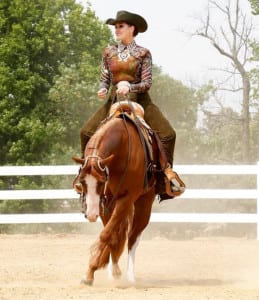 For Frid, a pretty pivoting Horsemanship horse has the following elements: they drop their neck, look slightly into the turn, and their hip rotates underneath them to the inside of the pivot.
For Frid, a pretty pivoting Horsemanship horse has the following elements: they drop their neck, look slightly into the turn, and their hip rotates underneath them to the inside of the pivot.
Unlike Showmanship though, where holding that pivot foot is crucial, Frid had something interesting to say about a Horsemanship horse: “I believe in my heart that a Horsemanship horse doesn’t need to hold a pivot foot. In Horsemanship, it’s all about cadence and correctness, with speed being secondary. Rhythm is more important.”
That all being said, Frid narrowed down a perfect Horsemanship pivot to one very simple concept.
He said, “the horse needs to turn underneath the person, the person does not turn above the horse.”
He continued, “A lot of times I see a person turning before the horse even moves. This mistake runs the risk of the rider getting ahead of or behind the horse so the horse will either walk or back out of the pivot.”
“For Horsemanship, the horse needs to turn off the rider’s leg,” he said, “not off the hands or the reins.”
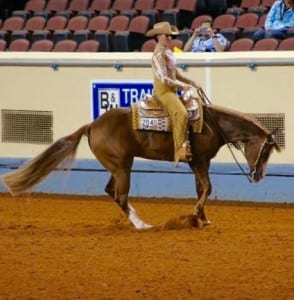 And that’s not to say your reins aren’t important. For Frid, the correct rein length does make a difference.
And that’s not to say your reins aren’t important. For Frid, the correct rein length does make a difference.
“If you have too short of a rein that will bind the horse up and they can back out [of the pivot],” he said, “if your reins are too long that makes the horse loose and they can walk out.”
The correct rein length allows a rider to “hold their horse into the turn.”
And similar to a handler having control of a Showmanship horse’s head, neck, and shoulder, Frid expects riders to have control of EVERY single body part on a Horsemanship horse.
He explained what he does at home so horses are show pen ready when the time comes.
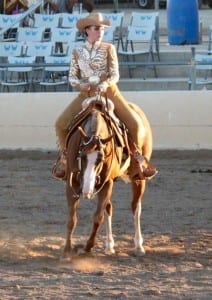 “I like to be able to push any part of the body around when I ask a horse to turn.”
“I like to be able to push any part of the body around when I ask a horse to turn.”
“Let’s say I’m asking for a turn to the right,” Frid said, “I might take their head off to the left and push their rib cage into the turn, while still asking them to turn. This is very uncomfortable for the horse but he starts to understand that you can move each body part while still keeping a rhythm.”
Frid explained that the point of this type of exercise is to push the horse out of their “comfort zone” so when asked to perform a “correct” pivot, it is the “easiest thing for them to do.”
Lastly, he warned against Horsemanship riders looking to the inside of the pivot with their horse.
“Riders need to stay square and keep their eyes up and ahead,” said Frid.
How Pivots Make a Difference in Your Score
There is a huge difference in how pivots are scored in the Showmanship compared to the Horsemanship.
“First of all, a Showmanship horse has to stick that pivot foot,” Frid said, “If the horse has a slight move of a pivot foot that is a minor fault. An obvious move of the pivot foot is a major fault.”
 Basically, if your horse moves that pivot foot you are looking at a fault of up to 10 points.
Basically, if your horse moves that pivot foot you are looking at a fault of up to 10 points.
Other elements that will affect your pivot maneuver score negatively in Showmanship are: a horse that bends its head or holds its pivot foot but does not remain square.
“These kinds of things will mark a below average pivot,” said Frid.
In Horsemanship, however, there are no direct faults associated with a horse planting that pivot foot.
“It’s a maneuver score only,” said Frid, “but in order to get a plus that horse’s hip needs to stay underneath them and they need to move with cadence and rhythm.”
In the end, whether you are showing in Showmanship or Horsemanship, being able to execute a smooth pivot that exemplifies cadence and rhythm will do nothing but improve your overall score, so be sure you don’t neglect to practice at home.
Photos © Emajes Design, Delores Kuhlwein, and Kaleena Katz Weakly









